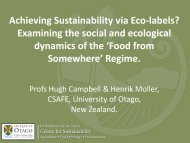Book of Abstract (incl. addendum) - IFSA symposium 2012
Book of Abstract (incl. addendum) - IFSA symposium 2012
Book of Abstract (incl. addendum) - IFSA symposium 2012
You also want an ePaper? Increase the reach of your titles
YUMPU automatically turns print PDFs into web optimized ePapers that Google loves.
Workshop 2.3 Systems thinking and practice in rural innovation: advances in concept,<br />
methodologies and interventions<br />
resource management innovation. However, there are increasing conceptual and practical challenges in<br />
creating and governing such systems for innovation. The challenge <strong>of</strong> organising for innovation has<br />
come into recent focus in Australian primary industries through federal government initiatives focusing<br />
on greater efficiency and effectiveness from research to support sector productivity (PISC, 2010).<br />
With multiple research organisations and interests and geographically distributed practitioners and<br />
communities, questions about how to organise and manage for enhanced innovation have come to the<br />
foreground.<br />
This paper reviews and analyses four different models or approaches to innovation<br />
conceptualised as operating in the Australian dairyfarming sector between June 2009 and 2010. The<br />
unit <strong>of</strong> analysis was the innovation program area or domain (e.g. milk quality, animal performance or<br />
people development) rather than specific projects or specific practices or technologies. The strengths,<br />
weaknesses and risks associated with the different models are explored. One particular model, (named<br />
by the authors “Development-led innovation”) emphasises the need for and role <strong>of</strong> program<br />
development as a social platform whereby public and commercial interests and networks are engaged<br />
in ongoing, joint action. This model mirrors key features <strong>of</strong> open innovation and may be best<br />
considered as a support structure for innovation. Challenges in implementation concern the<br />
governance arrangements; the re-configuration <strong>of</strong> “research-led” innovation cultures; and the measures<br />
<strong>of</strong> “development” success.<br />
Multi-stakeholder creation <strong>of</strong> social-ecological win-win solutions – mangling<br />
sustainable nitrate reductions in a Danish sub-catchment setting<br />
Anne Mette S. Langvad<br />
Aarhus University, Denmark<br />
Annemette.Langvad@agrsci.dk<br />
The purpose <strong>of</strong> this paper is to explore why multi-stakeholder creation <strong>of</strong> win-win solutions and<br />
sustainable transition processes turn out to be so difficult in social-ecological management practice.<br />
The paper is based on a qualitative longitudinal case study <strong>of</strong> decision makings within a group <strong>of</strong><br />
primary stakeholders <strong>of</strong> water environmental management organized around a sub catchment to a<br />
Danish fiord. By way <strong>of</strong> participant observation I follow the collective search for and construction <strong>of</strong><br />
measurements to nitrate reduction that are potentially sustainable in the sense that they prove beneficial<br />
to all <strong>of</strong> the involved stakeholders.<br />
I take a process analytical, performative and STS inspired approach (e.g. Pickering 1995) to<br />
unveiling the micro-political processes involved in multi-stakeholder managing.<br />
Through an analysis <strong>of</strong> the emergence, decision making and closing down <strong>of</strong> decision events, I<br />
identify material and social aspects <strong>of</strong> agency, their ‘interactive stabilizations’ and how they come to<br />
determine the continued structuring <strong>of</strong> win-win potentialities.<br />
In line with the performative approach, no pre-analytical assumptions <strong>of</strong> specific stake-holder<br />
interests and perspectives are made. Rather perspective formation is empirically investigated and<br />
special focus put upon how stakeholders’ mobilize material and social elements in searching for certain<br />
courses <strong>of</strong> nitrate reducing action.<br />
Stakeholders draw on elements <strong>of</strong> an existing water management regime. But instead <strong>of</strong> seeing<br />
the regime as something external and structuring to practice, I argue that an approach directly<br />
interested in sustainable transition has to view regime elements as instrinsically interwoven with and<br />
internal to practice.<br />
By explaining in this manner why the construction <strong>of</strong> win-win solutions is so difficult in practice<br />
a more pr<strong>of</strong>ound understanding <strong>of</strong> transition management is reached for.<br />
43











